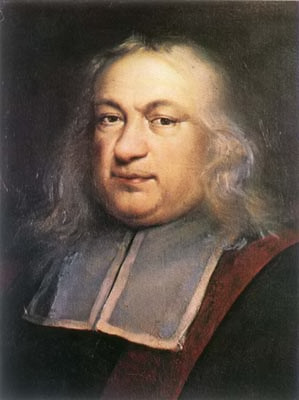Et cette proposition est généralement vraie en toutes progressions et en tous nombres premiers; de quoi je vous envoierois la démonstration, si je n'appréhendois d'être trop long.
Fermat (in a letter dated October 18, 1640 to his friend and confidant Frénicle de Bessy) commenting on his statement that p divides a<sup> p−1</sup> − 1 whenever p is prime and a is coprime to p (this is what is now known as Fermat's little theorem).
Pierre de Fermat: Citáty v angličtine
“I have discovered a truly remarkable proof of this theorem which this margin is too small to contain.”
Cuius rei demonstrationem mirabilem sane detexi hanc marginis exiguitas non caperet.
Note written on the margins of his copy of Claude-Gaspar Bachet's translation of the famous Arithmetica of Diophantus, this was taken as an indication of what became known as Fermat's last theorem, a correct proof for which would be found only 357 years later; as quoted in Number Theory in Science and Communication (1997) by Manfred Robert Schroeder
Letter to Frénicle (1657) Oeuvres de Fermat Vol.II as quoted by Edward Everett Whitford, The Pell Equation http://books.google.com/books?id=L6QKAAAAYAAJ (1912)
Kontext: There is scarcely any one who states purely arithmetical questions, scarcely any who understands them. Is this not because arithmetic has been treated up to this time geometrically rather than arithmetically? This certainly is indicated by many works ancient and modern. Diophantus himself also indicates this. But he has freed himself from geometry a little more than others have, in that he limits his analysis to rational numbers only; nevertheless the Zetcica of Vieta, in which the methods of Diophantus are extended to continuous magnitude and therefore to geometry, witness the insufficient separation of arithmetic from geometry. Now arithmetic has a special domain of its own, the theory of numbers. This was touched upon but only to a slight degree by Euclid in his Elements, and by those who followed him it has not been sufficiently extended, unless perchance it lies hid in those books of Diophantus which the ravages of time have destroyed. Arithmeticians have now to develop or restore it. To these, that I may lead the way, I propose this theorem to be proved or problem to be solved. If they succeed in discovering the proof or solution, they will acknowledge that questions of this kind are not inferior to the more celebrated ones from geometry either for depth or difficulty or method of proof: Given any number which is not a square, there also exists an infinite number of squares such that when multiplied into the given number and unity is added to the product, the result is a square.
Letter to Frénicle (1657) Oeuvres de Fermat Vol.II as quoted by Edward Everett Whitford, The Pell Equation http://books.google.com/books?id=L6QKAAAAYAAJ (1912)
Kontext: There is scarcely any one who states purely arithmetical questions, scarcely any who understands them. Is this not because arithmetic has been treated up to this time geometrically rather than arithmetically? This certainly is indicated by many works ancient and modern. Diophantus himself also indicates this. But he has freed himself from geometry a little more than others have, in that he limits his analysis to rational numbers only; nevertheless the Zetcica of Vieta, in which the methods of Diophantus are extended to continuous magnitude and therefore to geometry, witness the insufficient separation of arithmetic from geometry. Now arithmetic has a special domain of its own, the theory of numbers. This was touched upon but only to a slight degree by Euclid in his Elements, and by those who followed him it has not been sufficiently extended, unless perchance it lies hid in those books of Diophantus which the ravages of time have destroyed. Arithmeticians have now to develop or restore it. To these, that I may lead the way, I propose this theorem to be proved or problem to be solved. If they succeed in discovering the proof or solution, they will acknowledge that questions of this kind are not inferior to the more celebrated ones from geometry either for depth or difficulty or method of proof: Given any number which is not a square, there also exists an infinite number of squares such that when multiplied into the given number and unity is added to the product, the result is a square.
Epist. XLII, written at Toulouse (Jan. 1, 1662) and reprinted in Œvres de Fermat, ii, p. 457; i, pp. 170, 173, as quoted by E. T. Whittaker, A History of the Theories of Aether and Electricity from the Age of Descartes to the Close of the Nineteenth Century (1910) p. 10. https://books.google.com/books?id=CGJDAAAAIAAJ&pg=PA10
